Mold Affects You, Find Out How
Mold affects you! People react differently to mold exposure. A person that lives in a mold infested house may never show symptoms (thought this is very rare). Another person might have a sneezing fit, headache, dizziness, or watery eyes from just being next to a cardboard box with a small section of mold growth on it.
In another case, one person might live in a house with mold growth and only have an occasional headache or slight brain fog. But another person in the same home might develop a serious debilitating respiratory disease.
There are several factors that contribute to how our bodies react to mold. These include the type of mold, the amount of mold, how we are exposed to it, and ultimately our unique physiology. But an important thing to note is that regardless of the degree of your symptoms, the presence of mold can be causing damage to your health. You may not be showing symptoms yet but could shortly or much later.
Whether or not you or a family member is highly sensitive to mold, consider the following steps to reduce your mold exposure.
1. Learn about the different mold types and how they personally affect you.
Mold grows both outside and inside in Tucson, AZ. It thrives on water sources like leaky pipes or even moderate moisture in air. There are thousands of species of mold. Some like Penicillium are used in medical treatment but even these can create deadly reactions in mold-sensitive persons. It just depends because everyone has different physiology and therefore different reactions to mold. No matter who you are and your physiology, it’s important to know about common types of mold, what kind of molds you have (or currently) come in contact with, and if you are experiencing symptoms of mold exposure when you do. Below you’ll find a list of some of the more common molds found in homes. There are of course thousands of species of mold so this only covers a portion of the types of molds you will most likely come in contact with during your lifetime.
Common Mold Types in Homes Tucson, AZ1
Aspergillus – This mold type has favorable growth in foods high in sugar, salt, and other solutes and oxygen-rich environments. It is known to grow aggressively on surfaces and foods.

Cladosporium – This mold type is known to be severely dangerous to asthmatics and those with respiratory diseases. It produces millions of airborne spores that act as very aggressive allergens.
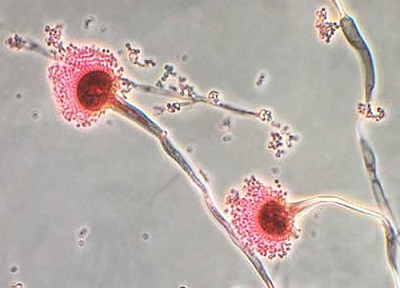
Penicillium – This mold type (in some members) provides as an antibiotic but can still create a powerful allergic reaction in many. It is one of the more common allergen questions by health care workers. It prefers growth in cool climates.
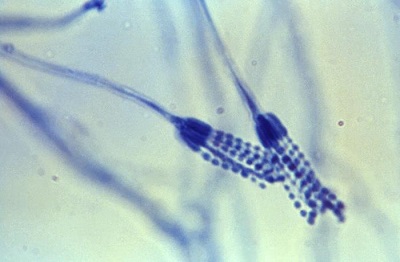
Alternaria – This mold type grows indoors and can cause hay fever and trigger asthma as well as induce infections in persons who are immunocompromised.
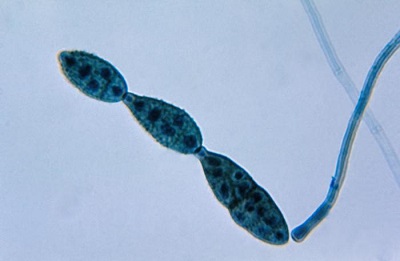
Common Symptoms to Mold Types Tucson, AZ2
- Coughing
- Nasal congestion
- Sneezing
- Irritated eyes
- Itchy throat
- Runny nose
- Wheezing
- Triggering of asthma symptoms
2. Stay up to date on mold forecasts in Tucson, AZ through allergy alerts and resources.
Allergy Alerts Tucson, AZ
If you believe you are suffering from allergies and/or asthma in Tucson, AZ you should contact a health provider to seek help. To supplement seeking professional health care, online sources about Relief Tests have also been made available by the American College of Allergy, Asthma, & Immunology. You can also visit the U.S. Environmental Protection Agency’s Air Now site that reports every day on air quality in the entire country including Tucson, AZ. Air quality ratings can be viewed on a map as well as through a table that lists by city.
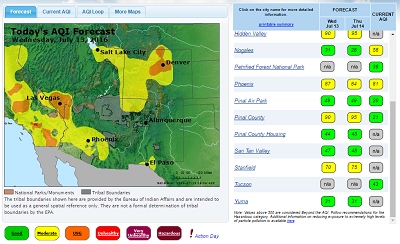
For staying up-to-date on allergens (while on the run or out and about ) in Tucson, AZ use Pollen.com’s Allergy Alert app and email alerts. The app gives a daily “Allergy Forecast” rating indicating if predominant pollens like grasses, ragweed, and chenopods are low, moderate, high, or somewhere in between. As a bonus there is a quick daily temperature and weather report for the 4 days aheads along with the anticipated allergy forecast rating. This can be extremely helpful in planning for days in the park, and specifically what days you might want to avoid going.
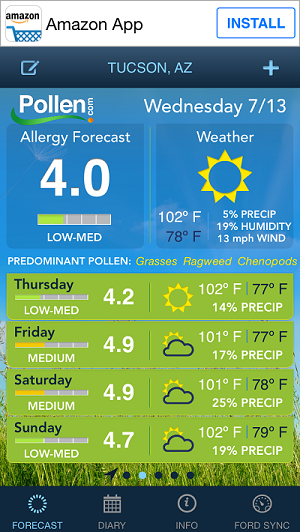
3. Remember your allergy medication when you leave your home.
Make it a habit to take your allergy medication with you everywhere. Even if you don’t believe you’ll need it, allergens that are airborne can’t usually be seen. This makes it difficult to predict when you may have an allergic reaction to mold either inside or outside. This is especially important if your medication is not over the counter, and so can not be quickly picked up at the closest convenient store.
4. Plan before going to businesses, parks, and other places.
This is where that allergy forecast app we talk about above will come in handy. If you know you’ll be spending time in a park or a business like a flower shop, plan the time of day you’ll go and how long you’ll stay. And check those allergy alerts before and during your outing. If the current day has a high allergy forecast but the following days are low to moderate, then you may want to change your plans.
5. Keep your home clean.
Your home is probably where you spend the majority of your time. Make sure that you regularly clean your home. This will help in reducing debris and organic matter that mold can grow on. Vacuum and wash floors regularly, remove dust and dirt, and clean furniture. Keeping your home free of clutter will also reduce the chance of hidden mold. The kind that could be growing on the pizza box under the bed or on the wall behind the dresser. You’ll reduce the number of things that mold can grow on and create more visual lines for inspecting your home for possible mold growth.
6. Regularly check for unwanted sources of water.
Unwanted sources of water include, but are not limited to, leaky faucets, a broken dishwasher or washing machine, busted pipes, or malfunctioning sprinklers. Check pipes and faucets regularly to ensure that water is not accumulating under sinks, on the floor or carpet, or behind walls. Inspect your dishwasher and washing machine during and after cycles to make sure that water is staying inside the appliances. Unwanted water sources are not only hiking up your water bill but most likely feeding a mold type. An outside sprinkler that is malfunctioning could be regularly shooting water onto the home, creating a leak in the house over time and feeding a mold source.
Also, check your home after a rainstorm. Just think of a rainstorm as a test of any leaks in your roof or other problem areas.
7. Ask for a mold inspection of your home or workplace.
Maybe you suspect there is mold in your home or workplace either by a visual presence, an odor, symptoms of mold exposure, or a combination of these. In any circumstance, contact a local professional team of licensed mold inspectors. Remember that in Tucson, AZ home inspectors are not required to be licensed for mold inspections or to perform them in the first place. You must find a company licensed to perform a mold inspection. This will include a visual inspection and possibly air quality testing.
RELEVANT NEWS STORY
One family in Atlanta was suffering from mold exposure in their apartment and had to reach out to the local news. The news contracted a licensed mold inspector to perform a professional air quality test in which airborne mold spores of the type Penicillium were found. The owners of the apartment complex then hired a professional mold remediation company to remove the mold. This story highlights the dangers of mold exposure and the important work that is necessary to remove it. The family stayed in a hotel, courtesy of the apartment complex owners, until the mold was completely removed.3
8. Reduce the amount of moisture in your home.
Because so many different types of mold can thrive in environment with moderate moisture, it’s important to keep your home or workplace as dry as possible. Use ventilation systems, especially in kitchens and bathrooms, to help remove moisture. Common sources of moisture are cooking, showering, and doing laundry with a washing machine and dryer. If you don’t have ventilation systems, contact a company like Royalty Renovation in Tucson, AZ to install them for you.
Be mindful of all the ways in which moisture is created in your home. Taking shorter and colder showers can help reduce moisture. And opening windows nearby after. The temperature outside and inside your home can also have an impact on how much moisture is collecting in your home. Consider adjusting the temperature in your home as this can impact moisture.
9. Filter the air in your home.
Running HEPA (high-efficiency particulate arrestance) filters, that meet United States Department of Energy standards for air quality filtering, can help with reducing the concentration of mold spores in the air. They can’t, however, completely remove all airborne spores. If there is mold growth in a home, workplace, or childcare facility, then the mold should be removed and action taken to reduce the chance of regrowth. This would include removing unwanted sources of water and reducing moisture in the building. But using filters are a good way to cut down on all types of allergens in a home and gives you a little more safety if there is time between when mold first grows, when you first discover it, and when it is finally removed.
10. Check areas around your home.
Regularly check areas around your home for the possible presence of mold. While there are thousands of species of mold with vast characteristic differences, there are some general similarities in appearance. Common types of mold in homes will usually present as light to dark spots and/or streaks on surfaces, walls, ceilings, and floors. If you see any patterns like this on walls, floors, ceilings, cupboards, surfaces, or other areas then you should contact a professional mold inspection company. Licensed mold inspectors will be able to perform a visual inspection and if needed run an air quality test.
11. Fix water damage issues and/or mold damage quickly.
A large factor in dealing with mold exposure is response time. If mold is present or suspected of being present, you want to act quickly to reduce your exposure, stop the growth from getting worse, and cutting of the water and/or moisture source that is feeding the mold. The quicker you act, the less exposure time you have to the mold. You can also reduce the cost of damages associated with mold growth by catching it early before it spreads to more parts of your home. Often mold remediation requires not only the removal of the mold but also the parts of the home it has grown into. This can result in drywall removal, cabinet displacement, or other extensive work that will then need to be replaced by a renovation and remodeling company.
While these are some of the most important steps that we see can be taken to reducing mold exposure, please share with us if you think of any that should also be listed.
References
- Centers for Disease Control and Prevention. 2016. “Mold – Basic Facts”. http://www.cdc.gov/mold/faqs.htm
- American College of Allergy, Asthma, & Immunology. 2016. “Types of Allergies, Mold Allergy”. http://acaai.org/allergies/types/mold-allergy
- Heaton Environmental. 2014. “Mold forces Duluth family out of apartment, causes illness CBS Atlanta News 3”. https://www.youtube.com/watch?v=evZ5-wiWRl0

